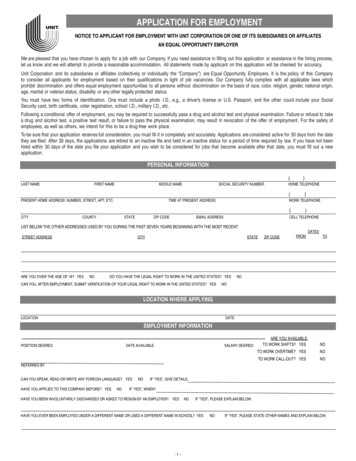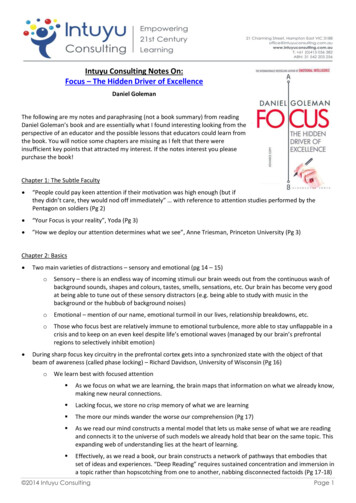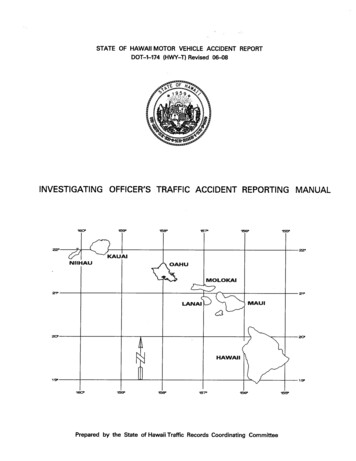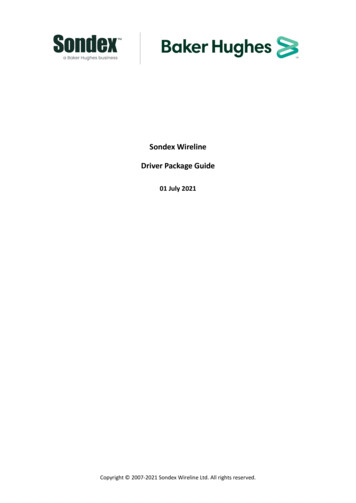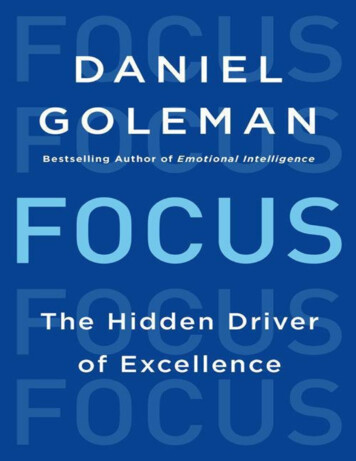
Transcription
DEDICATIONFor the well-being of generations to come
CONTENTSDedication1The Subtle FacultyPart I: The Anatomy of Attention2Basics3Attention Top and Bottom4The Value of a Mind Adrift5Finding BalancePart II: Self-Awareness6The Inner Rudder7Seeing Ourselves as Others See Us8A Recipe for Self-ControlPart III: Reading Others910The Woman Who Knew Too MuchThe Empathy Triad
11Social SensitivityPart IV: The Bigger Context12Patterns, Systems, and Messes13System Blindness14Distant ThreatsPart V: Smart Practice15The Myth of 10,000 Hours16Brains on Games17Breathing BuddiesPart VI: The Well-Focused Leader18How Leaders Direct Attention19The Leader’s Triple Focus20What Makes a Leader?Part VII: The Big Picture21Leading for the Long FutureAcknowledgmentsResourcesNotesIndexAbout the AuthorAlso by Daniel GolemanCreditsCopyrightAbout the PublisherFootnotes
1THE SUBTLE FACULTYTo watch John Berger, house detective, track the shoppers wandering the firstfloor of a department store on Manhattan’s Upper East Side is to witnessattention in action. In a nondescript black suit, white shirt, and red tie, walkietalkie in hand, John moves perpetually, his focus always riveted on one oranother shopper. Call him the eyes of the store.It’s a daunting challenge. There are more than fifty shoppers on his floor atany one time, drifting from one jewelry counter to the next, perusing theValentino scarves, sorting through the Prada pouches. As they browse the goods,John browses them.John waltzes among the shoppers, a study in Brownian motion. For a fewseconds he stands behind a purse counter, his eyes glued to a prospect, then flitsto a vantage point by the door, only to glide to a corner where a perch allows hima circumspect look at a potentially suspicious trio.While customers see only the merchandise, oblivious to John’s watchful eye,he scrutinizes them all.There’s a saying in India, “When a pickpocket meets a saint, all he sees arethe pockets.” In any crowd what John would see are the pickpockets. His gazeroams like a spotlight. I can imagine his face seeming to screw up into a giant
ocular orb reminiscent of the one-eyed Cyclops. John is focus embodied.What does he scan for? “It’s a way their eyes move, or a motion in theirbody” that tips him off to the intention to pilfer, John tells me. Or those shoppersbunched together, or the one furtively glancing around. “I’ve been doing this solong I just know the signs.”As John zeroes in on one shopper among the fifty, he manages to ignore theother forty-nine, and everything else—a feat of concentration amid a sea ofdistraction.Such panoramic awareness, alternating with his constant vigilance for atelling but rare signal, demands several varieties of attention—sustainedattention, alerting, orienting, and managing all that—each based in a distinctly1unique web of brain circuitry, and each an essential mental tool.John’s sustained scan for a rare event represents one of the first facets ofattention to be studied scientifically. Analysis of what helped us stay vigilantstarted during World War II, spurred on by the military’s need to have radaroperators who could stay at peak alert for hours—and by the finding that theymissed more signals toward the end of their watch, as attention lagged.At the height of the Cold War, I remember visiting a researcher who had beencommissioned by the Pentagon to study vigilance levels during sleep deprivationlasting three to five days—about how long it estimated the military officers deepin some bunker would need to stay awake during World War III. Fortunately hisexperiment never had to be tested against hard reality, although his encouragingfinding was that even after three or more sleepless nights people could pay keenattention if their motivation was high enough (but if they didn’t care, they wouldnod off immediately).In very recent years the science of attention has blossomed far beyondvigilance. That science tells us these skills determine how well we perform anytask. If they are stunted, we do poorly; if muscular, we can excel. Our verynimbleness in life depends on this subtle faculty. While the link between
attention and excellence remains hidden most of the time, it ripples throughalmost everything we seek to accomplish.This supple tool embeds within countless mental operations. A short list ofsome basics includes comprehension, memory, learning, sensing how we feeland why, reading emotions in other people, and interacting smoothly. Surfacingthis invisible factor in effectiveness lets us better see the benefits of improvingthis mental faculty, and better understand just how to do that.Through an optical illusion of the mind we typically register the end productsof attention—our ideas good and bad, a telling wink or inviting smile, the whiffof morning coffee—without noticing the beam of awareness itself.Though it matters enormously for how we navigate life, attention in all itsvarieties represents a little-noticed and underrated mental asset. My goal here isto spotlight this elusive and underappreciated mental faculty in the mind’soperations and its role in living a fulfilling life.Our journey begins with exploring some basics of attention; John’s vigilantalertness marks just one of these. Cognitive science studies a wide array,including concentration, selective attention, and open awareness, as well as howthe mind deploys attention inwardly to oversee mental operations.Vital abilities build on such basic mechanics of our mental life. For one,there’s self-awareness, which fosters self-management. Then there’s empathy,the basis for skill in relationship. These are fundamentals of emotionalintelligence. As we’ll see, weakness here can sabotage a life or career, whilestrengths increase fulfillment and success.Beyond these domains, systems science takes us to wider bands of focus aswe regard the world around us, tuning us to the complex systems that define and2constrain our world. Such an outer focus confronts a hidden challenge inattuning to these vital systems: our brain was not designed for that task, and sowe flounder. Yet systems awareness helps us grasp the workings of anorganization, an economy, or the global processes that support life on this planet.
All that can be boiled down to a threesome: inner, other, and outer focus. Awell-lived life demands we be nimble in each. The good news on attentioncomes from neuroscience labs and school classrooms, where the findings pointto ways we can strengthen this vital muscle of the mind. Attention works muchlike a muscle—use it poorly and it can wither; work it well and it grows. We’llsee how smart practice can further develop and refine the muscle of ourattention, even rehab focus-starved brains.For leaders to get results they need all three kinds of focus. Inner focusattunes us to our intuitions, guiding values, and better decisions. Other focussmooths our connections to the people in our lives. And outer focus lets usnavigate in the larger world. A leader tuned out of his internal world will berudderless; one blind to the world of others will be clueless; those indifferent tothe larger systems within which they operate will be blindsided.And it’s not just leaders who benefit from a balance in this triple focus. All ofus live in daunting environments, rife with the tensions and competing goals andlures of modern life. Each of the three varieties of attention can help us find abalance where we can be both happy and productive.Attention, from the Latin attendere, to reach toward, connects us with ion,”cognitiveneuroscientists Michael Posner and Mary Rothbart write, provides themechanisms “that underlie our awareness of the world and the voluntary3regulation of our thoughts and feelings.”Anne Treisman, a dean of this research area, notes that how we deploy our4attention determines what we see. Or as Yoda says, “Your focus is your reality.”THE ENDANGERED HUMAN MOMENTThe little girl’s head came only up to her mother’s waist as she hugged her momand held on fiercely as they rode a ferry to a vacation island. The mother,
though, didn’t respond to her, or even seem to notice: she was absorbed in heriPad all the while.There was a reprise a few minutes later, as I was getting into a shared taxivan with nine sorority sisters who that night were journeying to a weekendgetaway. Within a minute of taking their seats in the dark van, dim lights flickedon as every one of the sisters checked an iPhone or tablet. Desultoryconversations sputtered along while they texted or scrolled through Facebook.But mostly there was silence.The indifference of that mother and the silence among the sisters aresymptoms of how technology captures our attention and disrupts ourconnections. In 2006 the word pizzled entered our lexicon; a combination ofpuzzled and pissed, it captured the feeling people had when the person they werewith whipped out a BlackBerry and started talking to someone else. Back thenpeople felt hurt and indignant in such moments. Today it’s the norm.Teens, the vanguard of our future, are the epicenter. In the early years of thisdecade their monthly text message count soared to 3,417, double the number just5a few years earlier. Meanwhile their time on the phone dropped. The averageAmerican teen gets and sends more than a hundred texts a day, about ten everywaking hour. I’ve seen a kid texting while he rode his bike.A friend reports, “I visited some cousins in New Jersey recently and theirkids had every electronic gadget known to man. All I ever saw were the tops oftheir heads. They were constantly checking their iPhones for who had textedthem, what had updated on Facebook, or they were lost in some video game.They’re totally unaware of what’s happening around them and clueless abouthow to interact with someone for any length of time.”Today’s children are growing up in a new reality, one where they are attuningmore to machines and less to people than has ever been true in human history.That’s troubling for several reasons. For one, the social and emotional circuitryof a child’s brain learns from contact and conversation with everyone it
encounters over the course of a day. These interactions mold brain circuitry; thefewer hours spent with people—and the more spent staring at a digitized screen—portends deficits.Digital engagement comes at a cost in face time with real people—themedium where we learn to “read” nonverbals. The new crop of natives in thisdigital world may be adroit at the keyboard, but they can be all thumbs when itcomes to reading behavior face-to-face, in real time—particularly in sensing thedismay of others when they stop to read a text in the middle of talking withthem.6A college student observes the loneliness and isolation that go along withliving in a virtual world of tweets, status updates, and “posting pictures of mydinner.” He notes that his classmates are losing their ability for conversation, letalone the soul-searching discussions that can enrich the college years. And, hesays, “no birthday, concert, hangout session, or party can be enjoyed withouttaking the time to distance yourself from what you are doing” to make sure thatthose in your digital world know instantly how much fun you are having.Then there are the basics of attention, the cognitive muscle that lets us followa story, see a task through to the end, learn, or create. In some ways, as we’ll see,the endless hours young people spend staring at electronic gadgets may helpthem acquire specific cognitive skills. But there are concerns and questionsabout how those same hours may lead to deficits in core mental skills.An eighth-grade teacher tells me that for many years she has had successiveclasses of students read the same book, Edith Hamilton’s Mythology. Herstudents have loved it—until five years or so ago. “I started to see kids not soexcited—even high-achieving groups could not get engaged with it,” she toldme. “They say the reading is too hard; the sentences are too complicated; it takesa long time to read a page.”She wonders if perhaps her students’ ability to read has been somehowcompromised by the short, choppy messages they get in texts. One student
confessed he’d spent two thousand hours in the last year playing video games.She adds, “It’s hard to teach comma rules when you are competing with Worldof WarCraft.”At the extremes, Taiwan, Korea, and other Asian countries see Internetaddiction—to gaming, social media, virtual realities—among youth as a nationalhealth crisis, isolating the young. Around 8 percent of American gamers betweenages eight and eighteen seem to meet psychiatry’s diagnostic criteria foraddiction; brain studies reveal changes in their neural reward system while they7game that are akin to those found in alcoholics and drug abusers. Occasionalhorror stories tell of addicted gamers who sleep all day and game all night, rarelystop to eat or clean themselves, and even get violent when family members try tostop them.Rapport demands joint attention—mutual focus. Our need to make an effortto have such human moments has never been greater, given the ocean ofdistractions we all navigate daily.THE IMPOVERISHMENT OF ATTENTIONThen there are the costs of attention decline among adults. In Mexico, anadvertising rep for a large radio network complains, “A few years ago you couldmake a five-minute video for your presentation at an ad agency. Today you haveto keep it to a minute and a half. If you don’t grab them by then, everyone startschecking for messages.”A college professor who teaches film tells me he’s reading a biography of oneof his heroes, the legendary French director François Truffaut. But, he finds, “Ican’t read more than two pages at a stretch. I get this overwhelming urge to goonline and see if I have a new email. I think I’m losing my ability to sustainconcentration on anything serious.”The inability to resist checking email or Facebook rather than focus on the
person talking to us leads to what the sociologist Erving Goffman, a masterlyobserver of social interaction, called an “away,” a gesture that tells anotherperson “I’m not interested” in what’s going on here and now.At the third All Things D(igital) conference back in 2005, conference hostsunplugged the Wi-Fi in the main ballroom because of the glow from laptopscreens, indicating that those in the audience were not glued to the actiononstage. They were away, in a state, as one participant put it, of “continuouspartial attention,” a mental blurriness induced by an overload of informationinputs from the speakers, the other people in the room, and what they were doing8on their laptops. To battle such partial focus today, some Silicon Valleyworkplaces have banned laptops, mobile phones, and other digital tools duringmeetings.After not checking her mobile for a while, a publishing executive confessesshe gets “a jangly feeling. You miss that hit you get when there’s a text. Youknow it’s not right to check your phone when you’re with someone, but it’saddictive.” So she and her husband have a pact: “When we get home from workwe put our phones in a drawer. If it’s in front of me I get anxious; I’ve just got tocheck it. But now we try to be more present for each other. We talk.”Our focus continually fights distractions, both inner and outer. The questionis, What are our distractors costing us? An executive at a financial firm tells me,“When I notice that my mind has been somewhere else during a meeting, Iwonder what opportunities I’ve been missing right here.”Patients are telling a physician I know that they are “self-medicating” withdrugs for attention deficit disorder or narcolepsy to keep up with their work. Alawyer tells him, “If I didn’t take this, I couldn’t read contracts.” Once patientsneeded a diagnosis for such prescriptions; now for many those medications havebecome routine performance enhancers. Growing numbers of teenagers arefaking symptoms of attention deficit to get prescriptions for stimulants, achemical route to attentiveness.
And Tony Schwartz, a consultant who coaches leaders on how to bestmanage their energy, tells me, “We get people to become more aware of howthey use attention—which is always poorly. Attention is now the number-oneissue on the minds of our clients.”The onslaught of incoming data leads to sloppy shortcuts, like triaging emailby heading, skipping much of voice mails, skimming messages and memos. It’snot just that we’ve developed habits of attention that make us less effective, butthat the weight of messages leaves us too little time simply to reflect on whatthey really mean.All of this was foreseen way back in 1977 by the Nobel-winning economistHerbert Simon. Writing about the coming information-rich world, he warned thatwhat information consumes is “the attention of its recipients. Hence a wealth of9information creates a poverty of attention.”
PART ITHE ANATOMY OF ATTENTION
2BASICSAs a teenager I got into the habit of listening to the string quartets of BélaBartók—which I found slightly cacophonous but still enjoyed—while doing myhomework. Somehow tuning out those discordant tones helped me focus on, say,the chemical equation for ammonium hydroxide.Years later, when I found myself writing articles on deadline for the New YorkTimes, I remembered that early drill in ignoring Bartók. At the Times I laboredaway in the midst of the science desk, which in those years occupied aclassroom-sized cavern into which were crammed desks for the dozen or soscience journalists and a half dozen editors.There was always a Bartók-ish hum of cacophony. Nearby there might bethree or four people chatting; you’d overhear the near end of a phoneconversation—or several—as reporters interviewed sources; editors shoutedacross the room to ask when an article would be ready for them. There wererarely, if ever, the sounds of silence.And yet we science writers, myself among them, would reliably deliver ourready-to-edit copy right on time, day after day. No one ever pleaded, Everyoneplease be quiet, so we could concentrate. We all just redoubled our focus, tuningout the roar.
That focus in the midst of a din indicates selective attention, the neuralcapacity to beam in on just one target while ignoring a staggering sea ofincoming stimuli, each one a potential focus in itself. This is what WilliamJames, a founder of modern psychology, meant when he defined attention as “thesudden taking possession by the mind, in clear and vivid form, of one of what1seems several simultaneously possible objects or trains of thought.”There are two main varieties of distractions: sensory and emotional. Thesensory distractors are easy: as you read these words you’re tuning out of theblank margins surrounding this text. Or notice for a moment the feeling of yourtongue against your upper palate—just one of an endless wave of incomingstimuli your brain weeds out from the continuous wash of background sounds,shapes and colors, tastes, smells, sensations, and on and on.More daunting is the second variety of lures: emotionally loaded signals.While you might find it easy to concentrate on answering your email in thehubbub of your local coffee shop, if you should overhear someone mention yourname (potent emotional bait, that) it’s almost impossible to tune out the voicethat carries it—your attention reflexively alerts to hear what’s being said aboutyou. Forget that email.The biggest challenge for even the most focused, though, comes from theemotional turmoil of our lives, like a recent blowup in a close relationship thatkeeps intruding into your thoughts. Such thoughts barge in for a good reason: toget us to think through what to do about what’s upsetting us. The dividing linebetween fruitless rumination and productive reflection lies in whether or not wecome up with some tentative solution or insight and then can let those distressingthoughts go—or if, on the other hand, we just keep obsessing over the same loopof worry.The more our focus gets disrupted, the worse we do. For instance, a test ofhow much college athletes are prone to having their concentration disrupted byanxiety correlates significantly with how well or poorly they will perform in the
2upcoming season.The ability to stay steady on one target and ignore everything else operates inthe brain’s prefrontal regions. Specialized circuitry in this area boosts thestrength of incoming signals we want to concentrate on (that email) anddampens down those we choose to ignore (those people chattering away at thenext table).Since focus demands we tune out our emotional distractions, our neuralwiring for selective attention includes that for inhibiting emotion. That meansthose who focus best are relatively immune to emotional turbulence, more ableto stay unflappable in a crisis and to keep on an even keel despite life’s3emotional waves.Failure to drop one focus and move on to others can, for example, leave themind lost in repeating loops of chronic anxiety. At clinical extremes it meansbeing lost in helplessness, hopelessness, and self-pity in depression; or panic andcatastrophizing in anxiety disorders; or countless repetitions of ritualisticthoughts or acts (touch the door fifty times before leaving) in obsessivecompulsive disorder. The power to disengage our attention from one thing andmove it to another is essential for well-being.The stronger our selective attention, the more powerfully we can stayabsorbed in what we’ve chosen to do: get swept away by a moving scene in afilm or find a powerful poetry passage exhilarating. Strong focus lets people losethemselves in YouTube or their homework to the point of being oblivious towhatever tumult might be nearby—or their parents calling them to come eatdinner.You can spot the focused folks at a party: they are able to immersethemselves in a conversation, their eyes locked on the other person as they stayfully absorbed in their words—despite that speaker next to them blaring theBeastie Boys. The unfocused, in contrast, are in continual play, their eyesgravitating to whatever might grab them, their attention adrift.
Richard Davidson, a neuroscientist at the University of Wisconsin, namesfocus as one of a handful of essential life abilities, each based in a separateneural system, that guide us through the turbulence of our inner lives, our4relationships, and whatever challenges life brings.During sharp focus, Davidson finds, key circuitry in the prefrontal cortex getsinto a synchronized state with the object of that beam of awareness, a state he5calls “phase-locking.” If people are focused on pressing a button each time theyhear a certain tone, the electrical signals in their prefrontal area fire precisely insynch with the target sound.The better your focus, the stronger your neural lock-in. But if instead of6concentration there’s a jumble of thoughts, synchrony vanishes. Just such a dropin synchrony marks people with attention deficit disorder.7We learn best with focused attention. As we focus on what we are learning,the brain maps that information on what we already know, making new neuralconnections. If you and a small toddler share attention toward something as youname it, the toddler learns that name; if her focus wanders as you say it, shewon’t.When our mind wanders off, our brain activates a host of brain circuits thatchatter about things that have nothing to do with what we’re trying to learn.Lacking focus, we store no crisp memory of what we’re learning.ZONING OUTTime for a quick quiz:1.What’s that technical term for brain wave synchrony with a sound youhear?2.What are the two main varieties of distraction?
3.What aspect of attention predicts how well college athletes perform?If you can answer these off the top of your head, you’ve been sustainingfocused attention while you read—the answers were in the last few pages of thisbook (and can be found at the bottom of this page).*If you can’t recall the answers, you may have been zoning out from time totime while you read. And you’re not alone.A reader’s mind typically wanders anywhere from 20 to 40 percent of thetime while perusing a text. The cost for students, not surprisingly, is that themore wandering, the worse their comprehension.8Even when our minds are not wandering, if the text turns to gibberish—likeWe must make some circus for the money, instead of We must make some moneyfor the circus—about 30 percent of the time readers continue reading along for asignificant stretch (an average of seventeen words) before catching it.As we read a book, a blog, or any narrative, our mind constructs a mentalmodel that lets us make sense of what we are reading and connects it to theuniverse of such models we already hold that bear on the same topic. Thisexpanding web of understanding lies at the heart of learning. The more we zoneout while building that web, and the sooner the lapse after we begin reading, themore holes.When we read a book, our brain constructs a network of pathways thatembodies that set of ideas and experiences. Contrast that deep comprehensionwith the interruptions and distractions that typify the ever-seductive Internet. Thebombardment of texts, videos, images, and miscellaneous of messages we getonline seems the enemy of the more full understanding that comes from whatNicholas Carr calls “deep reading,” which requires sustained concentration andimmersion in a topic rather than hopscotching from one to another, nabbing9disconnected factoids.As education migrates onto Web-based formats, the danger looms that the
multimedia mass of distractions we call the Internet will hamper learning. Wayback in the 1950s the philosopher Martin Heidegger warned against a looming“tide of technological revolution” that might “so captivate, bewitch, dazzle, andbeguile man that calculative thinking may someday come to be . . . the only way10of thinking.” That would come at the loss of “meditative thinking,” a mode ofreflection he saw as the essence of our humanity.I hear Heidegger’s warning in terms of the erosion of an ability at the core ofreflection, the capacity to sustain attention to an ongoing narrative. Deepthinking demands sustaining a focused mind. The more distracted we are, themore shallow our reflections; likewise, the shorter our reflections, the moretrivial they are likely to be. Heidegger, were he alive today, would be horrified ifasked to tweet.HAS ATTENTION SHRUNK?There’s a swing band from Shanghai playing lounge music in a crowded Swissconvention hall, with hundreds of people milling about. In the midst of themanic throng, standing stock-still at a small circular bar table, Clay Shirky haszoned in to his laptop and is typing furiously.I met Clay, a New York University–based social media maven, some yearsback, but rarely have the chance to see him in the flesh. For several minutes I’mstanding about three feet away from Clay, off to his right, watching him—positioned in his peripheral vision, if he had any attention bandwidth to spare.But Clay takes no notice until I speak his name. Then, startled, he looks up andwe start chatting.Attention is a limited capacity: Clay’s rapt concentration fills that full boreuntil he shifts to me.“Seven plus or minus two” chunks of information has been taken as the upperlimit of the beam of attention since the 1950s, when George Miller proposed
what he called this “magical number” in one of psychology’s most influentialpapers.11More recently, though, some cognitive scientists have argued that four12chunks is the upper limit. That caught the public’s limited attention (for a briefmoment, anyway), as the new meme spread that this mental capacity had shrunkfrom seven to four bits of information. “Mind’s Limit Found: 4 Bits of13Information,” one science news site proclaimed.Some took the presumed downsizing of what we can hold in mind as anindictment of the distractedness of everyday life in the twenty-first century,decrying the shrinking of this crucial mental ability. But they misinterpret thedata.“Working memory hasn’t shrunk,” said Justin Halberda, a cognitive scientistat Johns Hopkins University. “It’s not the case that TV has made our workingmemory smaller”—that in the 1950s we all had an upper limit of seven plus orminus two bits of information, and now we have only four.“The mind tries to make the most of its limited resources,” Halberdaexplained. “So we use memory strategies that help”—say, combining differentelements, like 4, 1, and 5, into a single chunk, such as the area code 415. “Whenwe perform a memory task, the result might be seven plus or minus two bits. Butthat breaks down into a fixed limit of four, plus three or four more that memorystrategies add. So both four and seven are right, depending on how you measureit.”Then there’s what many people think of as “splitting” attention inmultitasking, which cognitive science tells us is a fiction, too. Rather thanhaving a stretchable balloon of attention to deploy in tandem, we have a narrow,fixed pipeline to allot. Instead of splitting it, we actually switch rapidly.Continual switching saps attention from full, concentrated engagement.“The most precious resource in a computer system is no longer its processor,memory, disk or network, but rather human attention,” a research group at
Carnegie Mellon University notes.14The solution they propose to this humanbottleneck hinges on minimizing distractions: Project Aura proposes to do awaywith bothersome systems glitches so we don’t waste time in hassles.The goal of a hassle-free computing system is laudable. This solution,however, may not get us that far: it’s not a technological fix we need but acognitive one. The source of distractions is not so much in the technology weuse as in the frontal assault on our focusing ability from the mounting tide ofdistractions.Which gets me back to Clay Shirky, particularly his research on social15media. While none of us can focus on eve
attention, even rehab focus-starved brains. For leaders to get results they need all three kinds of focus. Inner focus attunes us to our intuitions, guiding values, and better decisions. Other focus smooths our connections to the people in our lives. And outer focus lets us navigate in the larger world. A leader tuned out of his internal world .


